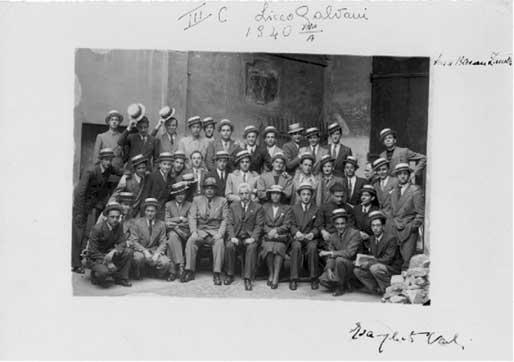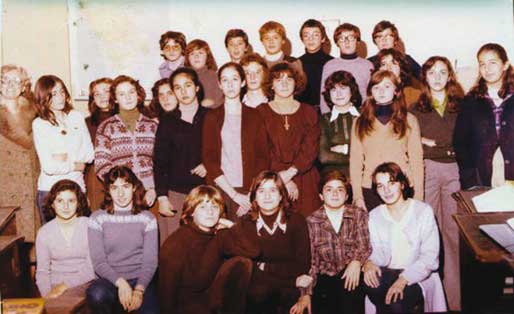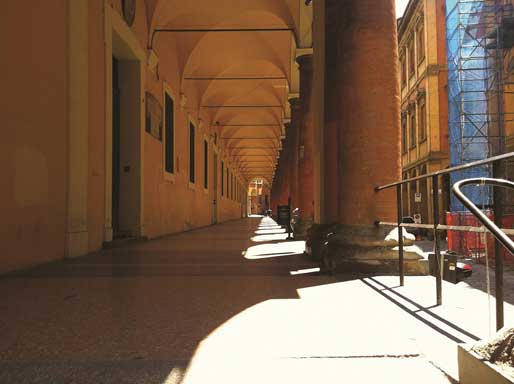As for numerous British or American colleges and
universities, now or in the past, there does not exist a "Galvani tie",
meaning a symbol, if we may say, a sign of belonging, indicating a special
education, a culture of excellence.
But, in substance, it is as though
it existed because in Bologna (and certainly a bit outside of Bologna) "to
be from Galvani", to have attended this Institution, grants a sort of
status symbol that is not lost, that is carried over the years, the
decades. Let us say: forever.
"Prestigious" is probably the adjective
that is most often used for Galvani Secondary School. It is also
"historical" because it was established in 1860 which saw the unification
of Italy.
Birth certificate: the decree of Minister Farini dated
February 12th, 1860; but when it opened, in October of the same year, it
had no denomination: it was simply called "Regio Secondary School". It was
named "R. Liceo Luigi Galvani" only in May 1865.
But why, in
Bologna, native city of men of letters, poets, and philosophers, dedicate
the first classic secondary school to a man of science instead? The
decision which, it seems, was taken by the College of Professors in
agreement with the City, was based on the fact that "in the minds of
people at the time, Galvani was highly esteemed and was consequently
honored". This is the explanation given by Prof. Angelo Campanelli,
Director of the establishment in 1960, in the rich and voluminous book
(1,285 pages) promoted and produced by the establishment's educators in
order to celebrate the first century of the foundation of Galvani
Secondary School, which is found on Via Castiglione in a building complex
established and developed, throughout the centuries, to be the main
offices, by antonomasia, of Bologna's classic school.
In fact, here,
were initially active and flourishing colleges of theological studies, the
gymnasium-secondary school of Jesuits (1549-1773) and of the Barnabite
Fathers (1773-1866), the Guinizzelli gymnasium (1866) and, finally, the
Galvani which, when it was founded in 1860 began to operate in another
venue found with much difficulty: some classrooms underneath the "portico
of Death", a name that is the least inviting, and that the
community council, on January 3rd, 1873, decided to name the "Galvani
School".
The premises however did not change and remained inadequate
and, therefore, unsatisfying. That is why school and community
authorities worked on the project and, finally, in
October 1882, the Institution could change its premises (definitely)
on Via Castiglione 38. This building is, among other things, a true
architectural jewel: the Zambeccari Hall (built in 1742 by Master Antonio
Marieloni) which was, from 1752, Bologna's first public library.



Years and decades went by; the school population
grew; the need to increase available space was more and more pressing.
Other environments were annexed to the school. Then came the Second World
War. In the last months of 1944, Galvani's classrooms were occupied by the
Pizzardi hospital for people suffering from tuberculosis and Galvani had
to move in the premises of the middle school on Calderini Square, with
very reduced hours. At the end of the war, in 1956-46, lengthy
disinfections needed to take place in the premises of Via Castiglione and
the, schooling at Galvani was hosted by Minghetti Secondary School, until
the school year of 1946-47 everything came back to normal.
It is
not only because of the ultra-secular history of this school that one who
studied there is granted, like it or not, with a special imprinting, it is
the pride to belong to a special family (an association of ex-teaching
staff and ex-students, called The Galvani Family is in fact alive and
well).
It is also because this family was (let us say: is)
composed, like elements of a special DNA, so many protagonists, over time,
in the literature, science, art, history of our country. A few names?
Carducci and Pascoli, Gaetano Arcangeli, Severino Ferrari, Riccardo
Bacchelli, Mario Missiroli, Gherardo Forni, Marino Moretti, Pier Paolo
Pasolini…
And then, even without a special name, a Galvanist is always
a Galvinist! Right?
Paola Rubbi (a Galvanist
myself)